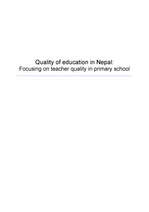

-
미리보기
소개
"quality of education in nepal. focusing on teacher quality in primary school"에 대한 내용입니다.목차
1. Introduction
2. Quality issues in primary school in Nepal
1) What is quality of education and how it is measured?
2) Why teacher quality is important?
3) Current status of Quality in primary education and teacher quality in Nepal
3. Conceptual framework for teacher quality
4. Assessment of teacher quality through the lens of Quality Framework
5. Inputs: qualifications
1) Lack of trained teachers affecting the quality of education
6. Process: management and practice in classroom
1) Problems with teaching methods in the Nepalese public schools
2) Poor teacher management systems in primary schools
7. Outcome: teacher effectiveness and student outcome
1) The relationship between teacher effectiveness and student achievement in primary schools
8. Conclusion본문내용
Nepal has experienced remarkable paradigm shifts of education over the last several years. ‘Access to education’ which is one of the most important national agendas was formed between the 1950s and 1990s and it has been changed from ‘access to education’ to ‘quality of education’ since 1990 (Koirala et al, 2013).
Before the 1950s, education was only for the privileged classes thereby it was limited for other people. In 1971, the Nepalese government introduced a new education system plan that increased school enrolment and access to basic education (Bhatta, 2008). However, during the expansion of the school enrolment and access to primary education agenda, the Nepalese government policy considered an increase in the number of schools. As a result, there were untrained and unqualified teachers including those teaching in primary schools (Government of Nepal, 2009). Hence, ‘the quality of education’ agenda has taken place since the 1990s (Koirala et al, 2013).참고자료
· An, X and Hannum, E and Sargent, T. (2008). Teaching Quality and Student Outcomes: Academic Achievement and Educational Engagement in Rural Northwest China, An International Journal, Vol.5, No.2 , p.309-334, China
· Archarya, U. D. (2002). Primary Education in Nepal: policy, problems, and prospects, Ekta, Kathmandu
· Asian Development Bank (ADB). (2012). Nepal: teacher education project, Validation Report
· Bennell, P. (2004). Teacher motivation and incentives in sub-Saharan Africa and Asia, UK, [Online], Available at: http://eldis.org/fulltext/dfidtea.pdf
· Bhatta, S. D. (2008). Tackling the problems of quality and disparity in Nepal’s school education: The OLPC model, Studies in Nepali History and Society, 13(1), p.17- 48
· Bista, M. B. (2006). Status female teachers in Nepal, UNESCO, Kathmandu, Nepal
· Brown, M and Ajmal, Y. (2011). Leading Learning: A report on effective school leadership, VSO, London
· CERID. (2002a). Journal of Early Childhood Development, vol. 5, Tribhvan University, Research Centre for Educational Innovation and Development (CERID), ECD Resource Centre, Balkhu, Kathmandu, Nepal
· CERID. (2002b). School Effectiveness in Nepal: A Synthesis of Indicators, CERID, Kathmandu, Nepal
· CERID. (2003). Effective Classroom Teaching/Learning Phase II: Transfer of Training Skills in the Classroom Delivery, CERID, Kathmandu, Nepal
· CERID. (2004). Effective Classroom Teaching Learning Phase III: School Based Assessment, Kathmandu, Nepal
· Department of Education. (2006). A study on Effectiveness of Primary Teacher
· Training in Nepal: final report, Government of Nepal, Kathmandu, Nepal
· Dilshad, R. M. (2010). Assessing quality of teacher education: a student perspective, Pakistan Journal of Social Science (PJSS), Vol.30, No. 1, p. 85-97
· Dolan, J., Golden, A., Ndaruhutse, S and Winthrop, R. (2012). Building effective teacher salary systems in fragile and conflict-affected states, the Centre for Universal Education at Brookings and CfBT Education Trust, USA and UK
· Gautam, K. C. (2008). Quality Basic Education as the Foundation for Nepal's Development, Kathmandu University, Kathmandu,
· [Online], Available at: http://files.eric.ed.gov/fulltext/ED491196.pdf
· Goe, L. (2007). The link between teacher quality and student outcomes: a research synthesis, National Comprehensive Centre for Teacher Quality, USA
· Government of Nepal. (2009). School Sector Reform Plan 2009-2015: Vulnerable community development framework (VCDF), Ministry of Education, Kathmandu, Nepal
· Hanushek, E. A and Rivkin, S. G. (2006). Teacher quality, [Online], Available at: http://hanushek.stanford.edu/sites/default/files/publications/Hanushek%2BRivkin%202006% 20HbEEdu%202.pdf
· Heck, R. H. (2009). Teacher effectiveness and student achievement: Investigating a multilevel cross-classified model, Journal of Educational Administration, Vol. 47, No. 2, p. 227-249, USA
· Karki, Y. B and Vashisth, K. (2014). Child-centred teaching: Facilitator’s perceptions and practices in Nepalese Early Childhood Development (ECD) centre, Chitkara University, Vol. 2, No.1, p.93-98, India
· Kelly, S. (2012). Assessing teacher quality: understanding teacher effect on instruction and achievement, Teachers College Press, New York
· Koirala, B. N and Bharati, S. (2013). The Effectiveness of the Teacher Training Quality Education Program: An evaluation report, Rural Education and Environment Department Centre (REED), Kathmandu, Nepal
· Lohani, S, Singh, R.B and Lohani, J. (2010). Universal primary education in Nepal: fulfilling the right to education, UNESCO IBE
· Maria, M. T and Jari, M. (2013). Comparison of Nepalese and Finnish Teachers´ Perceptions of Good Teaching , Asian journal of Humanities and Social Sciences (AJHSS), Vol.1, No. 2, NASA Unit, Educational Review Office and Ministry of Education, Kathmandu, Nepal
· Mcber, H. (2000). Research into Teacher Effectiveness: A Model of Teacher Effectiveness, DFEE, Norwich, UK
· McCaffrey, D. F, Sass, T. R and Lockwood, J. R. (2008). The intertemporal stability of teacher effect estimates, [Online],
· Available at: http://www.wcer.wisc.edu/news/events/vam%20conference%20final%20papers/intertempora
· lstability_mccaffreysasslockwood.pdf
· Ministry of Education. (2003). Education for All National Action Plan, Nepal National Commission for UNESCO, Kathmandu
· Ministry of Education. (2009). School Sector Reform Plan 2009-2015. Government of Nepal, Kathmandu
· Ministry of Education. (2011). School Level Educational Statistics of Nepal Consolidated Report 2010, Government of Nepal, Kathmandu
· Ministry of Education. (2013). School Sector Reform Plan Status Report 2011, Kathmandu, Nepal.
· Ministry of Education and Sports. (2004). The development of education: national report of Nepal, Kathmandu
· Ministry of Education and Sports. (2008). Primary education curriculum, Government of Nepal, Kathmandu
· Monazza, A. (2003). Determinants of student achievement in government and private schools in Pakistan, Pakistan Development Review, Vol. 42, No.4, p.841–876
· NAAC. (2007). Quality indicators for teacher education, National Assessment and Accreditation Council (NAAC), National Printing Press, India
· NCED. (2013). Terms of Reference (TOR) for the study Effectiveness of Teacher Professional Development (TPD) Program in Nepal, NCED, Nepal
· Ngware, M. W and Oketch, M and Ezeh, A.C. (2010). Quality of primary education inputs in urban schools: evidence from Nairobi, education and urban society, p. 1-26. SAGE, [Online], Available at: http://eus.sagepub.com/content/43/1/91
· Ngware, M. W and Oketch, M and Ezeh, A.C. (2011). Quality of primary education inputs in urban schools: evidence from Nairobi, education and urban society, 43(1), p.91-116, SAGE
· Nishimuko, M. (2007). Problems behind Education for All (EFA): The case of Sierra Leone, Eudcation research paper, Vol.7, No.2, p.19-29
· Norad. (2009). Joint Evaluation of Nepal’s Education for All 2004-2009 Sector Programme, Norwegian Agency for Development Cooperation, Oslo, Norway
· Parajuli, D. R and Das, T. (2013). Performance of community schools in Nepal: A micro level analysis, International journal of scientific &technology research, Vol.2, No.7
· Peters, S. J. (2007). An Input-Process-Outcome Framework for Inclusive Education in the South, Paper prepared for Presentation at the CASP-DISES South American Special Education Forum, Lima, Peru
· Pokharel, A. K and Paudel, J. (2013). Cultural factors causing differences in quality education, Tribhuvan University, Nepal
· Pradhan, L. (2011). Teacher education in Nepal, Journal of Educational and Social Research, Vol.1, No.5, Nepal
· Ravens, J. V. (2009). Early Childhood Development in Nepal: Expansion, Inclusion, Quality, A study to support the further development of Nepal’s national policy for early childhood, the Department of Education of Nepal and the National Office of UNICEF in Kathmandu, Nepal
· Sanjjad, S. (2009). Effective teaching methods at higher education level, University of Karachi, Pakistan
· Santwona Memorial Academy Educational Research Centre (SMAERC). (2008). A comparative study of school cost between community and institutional schools, final report, MOE, Nepal
· Sherestha, P. (2005). Lessons from the classroom: A policy research report on teacher’s motivation and perceptions in Nepal, VSO, UK, [Online], Available at: http://www.vsointernational.org/Images/lessons-from-classrooom-nepal_tcm76-22698.pdf
· Sommers, M. (2005). Islands of education: schooling, civil war and the southern Sudanese (1983–2004), IIEP-UNESECO, Paris
· Stephens, D. (2006). The quality of primary education in developing countries: who defines and who decides? [Online], Available at: http://dx.doi.org/10.1080/0305006910270208
· Strong, M. (2011). The Highly Qualified Teacher: What Is Teacher Quality and How Do We Measure It?, [Online], Available at: http://store.tcpress.com/0807752258.shtml
· Thapa. A. (2011). Does private school competition improve public school performance? The case of Nepal (unpublished doctoral dissertation), Columbia University, New York
· The Department of Education. (2012a). A study on the status of teacher management in community school in Nepal, Nepal, [Online], Available at:
· http://www.doe.gov.np/files/Files/A%20STUDY%20ON%20TEACHER%20MANAGEMENT%20OF%20COMMUNITY%20SCHOOL_2012_1374734006.pdf
· The Department of Education. (2012b). Flash report 2012-13, Ministry of Education, Government of Nepal, Sanothimi, Bhaktapur
· Timsina, T. P. (2008). School effectiveness with preference to the public and private schools in Nepal: an unpublished Mphil Dissertation. School of Education, Kathmandu University, Nepal
· UNESCO. (2006). Teachers and educational quality: monitoring global needs for 2015, Canada, [Online], Available at:
· https://www.google.co.uk/#q=teacher+quality+contributes+quality+of+education UNESCO. (2007). Education for All by 2015 Will we make it? , Education for All Global Monitoring Report 2008 summary, UNESCO, Paris
· UNESCO. (2013). Education for All Global Monitoring Report Policy Paper 07: Addressing the Learning Crisis in Early Grades, UNESCO, Paris
· UNESCO. (2014). Teaching and learning: achieving quality for all, Education for All Global Monitoring Report 2013/14, UNESCO, Paris
· UNICEF. (2000). Defining Quality in Education, Working Paper Series, Education Section, Programme Division, UNICEF, New York, USA
· UNICEF. (2010). Assessing the Impact of Seasonal Factors on School Attendance in the Karnali Zone, teacher’s union in Nepal
· UNICEF. (2011). The role of education in peacebuilding: Case study in Nepal, UNICEF, New York태그
-
자료후기
Ai 리뷰이 자료는 깊이 있는 내용과 함께 과제에 적용 가능한 내용이 많아 도움이 되었습니다. 과제에 바로 활용할 수 있어 매우 만족스러웠습니다. 감사합니다. -
자주묻는질문의 답변을 확인해 주세요

꼭 알아주세요
-
자료의 정보 및 내용의 진실성에 대하여 해피캠퍼스는 보증하지 않으며, 해당 정보 및 게시물 저작권과 기타 법적 책임은 자료 등록자에게 있습니다.
자료 및 게시물 내용의 불법적 이용, 무단 전재∙배포는 금지되어 있습니다.
저작권침해, 명예훼손 등 분쟁 요소 발견 시 고객센터의 저작권침해 신고센터를 이용해 주시기 바랍니다. -
해피캠퍼스는 구매자와 판매자 모두가 만족하는 서비스가 되도록 노력하고 있으며, 아래의 4가지 자료환불 조건을 꼭 확인해주시기 바랍니다.
파일오류 중복자료 저작권 없음 설명과 실제 내용 불일치 파일의 다운로드가 제대로 되지 않거나 파일형식에 맞는 프로그램으로 정상 작동하지 않는 경우 다른 자료와 70% 이상 내용이 일치하는 경우 (중복임을 확인할 수 있는 근거 필요함) 인터넷의 다른 사이트, 연구기관, 학교, 서적 등의 자료를 도용한 경우 자료의 설명과 실제 자료의 내용이 일치하지 않는 경우
찾으시던 자료가 아닌가요?
지금 보는 자료와 연관되어 있어요!
문서 초안을 생성해주는 EasyAI



